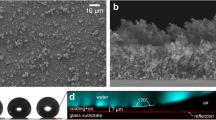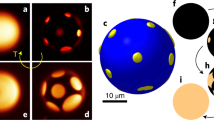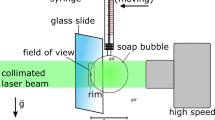Abstract
The shape1,2 and chemical composition3 of solid surfaces can be controlled at a mesoscopic scale. Exposing such structured substrates to a gas that is close to coexistence with its liquid phase can produce quite distinct adsorption characteristics compared to those of planar systems4, which may be important for technologies such as super-repellent surfaces5,6 or micro-fluidics7,8. Recent studies have concentrated on the adsorption of liquids on rough9,10,11 and heterogeneous12 substrates, and the characterization of nanoscopic liquid films13. But the fundamental effect of geometry on the adsorption of a fluid from the gas phase has hardly been addressed. Here we present a simple theoretical model which shows that varying the shape of the substrate can exert a profound influence on the adsorption isotherms of liquids. The model smoothly connects wetting and capillary condensation through a number of examples of fluid interfacial phenomena, and opens the possibility of tailoring the adsorption properties of solid substrates by sculpting their surface shape.
This is a preview of subscription content, access via your institution
Access options
Subscribe to this journal
Receive 51 print issues and online access
$199.00 per year
only $3.90 per issue
Buy this article
- Purchase on Springer Link
- Instant access to full article PDF
Prices may be subject to local taxes which are calculated during checkout




Similar content being viewed by others
References
Xia, Y. & Whitesides, G. M. Soft lithography. Angew. Chem. Int. Edn 37, 550–575 (1998).
Trau, M. et al. Microscopic patterning of orientated mesoscopic silica through guided growth. Nature 390, 674– 676 (1997).
Kumar, A., Abbott, N. A., Kim, E., Biebuyck, H. A. & Whitesides, G. M. Patterned self-assembled monolayers and meso-scale phenomena. Acc. Chem. Res. 28, 219– 226 (1995).
Dietrich, S. in Proceedings of the NATO-ASI “New Approaches to Old and New Problems in Liquid State Theory” (eds Caccamo, C., Hansen, J. P. & Stell, G.) 197–244 (Kluwer, Dordrecht, 1999).
Shibuichi, S., Yamamoto, T., Onda, T. & Tsujii, K. Super water- and oil-repellent surfaces resulting from fractal structure. J. Colloid Interf. Sci. 208, 287–294 (1998).
Bico, J., Marzolin, C. & Quere, D. Pearl drops. Europhys. Lett. 47, 220–226 (1999).
Weigl, B. H. & Yager, P. Microfluidics—Microfluidic diffusion-based separation and detection. Science 283, 346 –347 (1999).
Gravensen, P., Branebjerg, J. & Jensen, O. S. Microfluidics—a review. J. Micromech. Microeng. 3, 168–182 ( 1993).
Kardar, M. & Indekeu, J. O. Adsorption and wetting transitions on rough substrates. Europhys. Lett. 12, 161–166 (1990).
Giugliarelli, G. & Stella, A. L. Discontinuous interface depinning from a rough wall. Phys. Rev. E 53, 5035–5038 (1996).
Netz, R. R. & Andelman, D. Roughness-induced wetting. Phys. Rev. E 55, 687–700 (1997).
Gau, H., Herminghaus, S., Lenz, P. & Lipowsky, R. Liquid morphologies on structured surfaces: From microchannels to microchips. Science 283, 46–49 (1999).
Luna, M., Colchero, J. & Baro, A. M. Study of water droplets and films on graphite by noncontact scanning force microscopy. J. Phys. Chem. B 103, 9576–9581 (1999).
Dietrich, S. in Phase Transitions and Critical Phenomena (eds Domb, C. & Lebowitz, J. L.) Vol. 12, 1–218 (Academic, London, 1988).
Evans, R., Marconi, U. M. B. & Tarazona, P. Fluids in narrow pores: Adsorption, capillary condensation and critical points. J. Chem. Phys. 84, 2376–2399 (1986).
Christenson, H. K. Capillary condensation due to van der Waals attraction in wet slits. Phys. Rev. Lett. 73, 1821–1824 (1994).
Concus, P. & Finn, R. On the behaviour of a capillary surface in a wedge. Proc. Natl Acad. Sci. USA 63, 292–299 (1969).
Pomeau, Y. Wetting in a corner and related questions. J. Colloid. Interf. Sci. 113, 5–11 ( 1986).
Hauge, E. H. Macroscopic theory of wetting in a wedge. Phys. Rev. A 46, 4994–4998 (1992).
Neimark, A. V. & Kheifets, L. I. Solution of the problem of the equilibrium profile of the transition zone between a wetting film and the meniscus of the bulk phase in capillaries. Colloid. J. USSR 43, 402–407 ( 1981).
Rejmer, K., Dietrich, S. & Napiórkowski, M. Filling transition for a wedge. Phys. Rev. E 60, 4027–4042 (1999).
Parry, A. O., Rascón, C. & Wood, A. J. Critical effects at 3D wedge wetting. Phys. Rev. Lett. 85, 345–348 (2000).
Rascón, C. & Parry, A. O. Geometry dependent critical exponents at complete wetting. J. Chem. Phys. 112, 5175–5180 (2000).
Israelachvili, J. Intermolecular & Surface Forces (Academic, London, 1991).
Marconi, U. M. B. & Van Swol, F. Microscopic model for hysteresis and phase equilibria of fluids confined between parallel plates. Phys. Rev. A 39, 4109– 4116 (1989).
Acknowledgements
C.R. acknowledges financial support from the European Commission.
Author information
Authors and Affiliations
Corresponding author
Rights and permissions
About this article
Cite this article
Rascón, C., Parry, A. Geometry-dominated fluid adsorption on sculpted solid substrates. Nature 407, 986–989 (2000). https://doi.org/10.1038/35039590
Received:
Accepted:
Issue Date:
DOI: https://doi.org/10.1038/35039590
This article is cited by
-
Droplet-mediated long-range interfacial correlations. Exact field theory for entropic repulsion effects
Journal of High Energy Physics (2023)
-
Plasmonic gold nanostars@ZIF-8 nanocomposite for the ultrasensitive detection of gaseous formaldehyde
Journal of Materials Science (2021)
-
Helium in Nanoconfinement: Interplay Between Geometry and Wetting Behavior
Journal of Low Temperature Physics (2009)
-
The Trouble with Critical Wetting
Journal of Low Temperature Physics (2009)
-
Adsorption Within and On Regularly Patterned Substrates
Journal of Low Temperature Physics (2009)
Comments
By submitting a comment you agree to abide by our Terms and Community Guidelines. If you find something abusive or that does not comply with our terms or guidelines please flag it as inappropriate.



